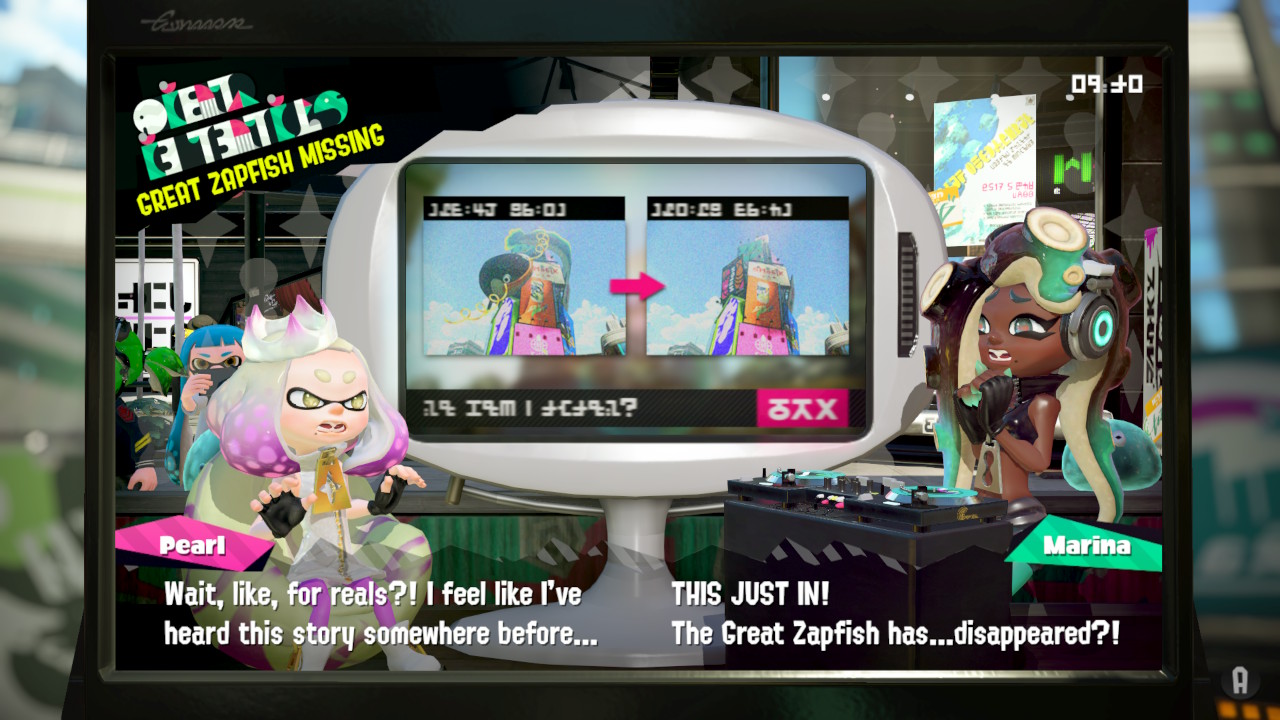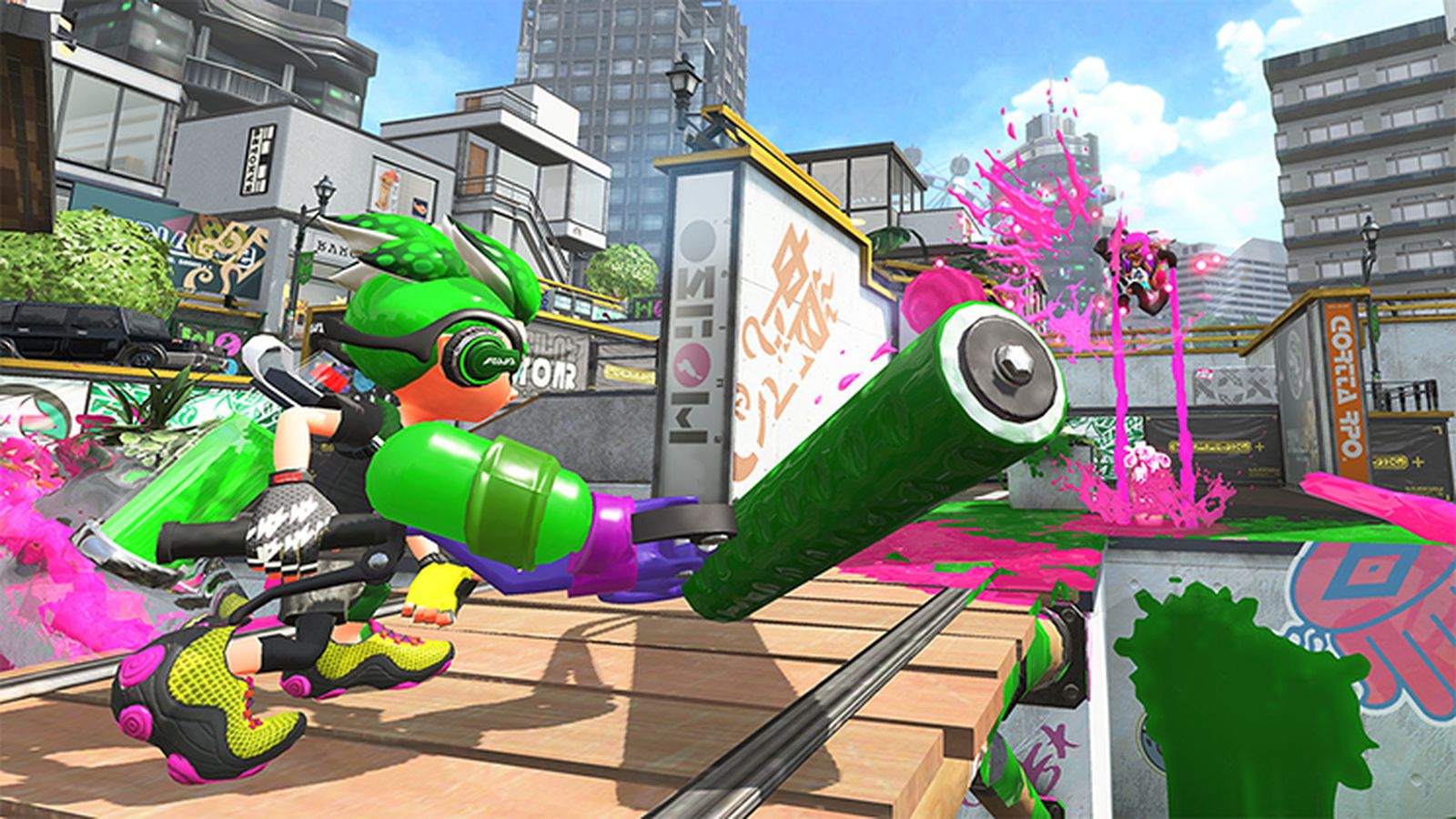While the Wii U had a decent lineup that included plenty of great titles, many of its games did not get to meet a wide audience due to poor console sales. As such, a number of those titles have been getting remasters, ports, or sequels on the Nintendo Switch. Splatoon 2 is one of these latter games, and hopes to capture fans of the original as well as new players with its updated graphics, enhanced gameplay, and expanded modes.
But does this new title have what it takes to be a fresh squid kid, or will it reek of month-old calamari? Dive into our review find out!
The Plot
Meet Pearl and Marina, your new hosts in Splatoon 2
Splatoon 2 takes place two years after the Octarians were defeated in the original Splatoon. At the very start of the game, you’ll be greeted by the two new hosts of SquidTV — Pearl and Marina — who will reveal that the Great Zapfish has disappeared once more. Not only that, but Squid Sister Callie has gone missing as well.
Should the player choose, they can enter a manhole on the left side of Inkopolis Square to enlist in Marie’s New Squidbeak Splatoon to help find the Great Zapfish by battling the Octarians once more.
Marie’s attitude and references to the first game are abound in Hero Mode
Splatoon 2’s story mode is a little more dynamic than the previous title, as Marie’s narration is filled with much more personality than Cap’n Cuttlefish. Other than that, most of the story is told through gameplay and brief conversations that ultimately lead to a battle with the final boss.
While the story mode has no real effect on the game as a whole, it’s a fun little diversion that can unlock rewards for the main game. Most of these are cosmetic — other than the tickets that can be used to buy food at Crusty Sean’s food truck to get experience and cash bonuses.
The Gameplay
Single Player
Splatoon 2‘s single player Hero Mode is more of the same to an extent, but it vastly improves upon the formula from the first game. Whereas players would be given a single mechanic to understand per-stage in the first game, Splatoon 2 very quickly incorporates various obstacles from the earlier stages into the next ones. This makes for a steeper difficulty curve than the original, and helps keep things feeling new as you progress along the campaign.
As you travel along the various stages you will meet various Octoling types, each with their own style of combat. The AI hasn’t improved by very much, but the developers seem to have compensated for that by increasing the number of enemies in an area at any given time. Not that the AI enemies needed to be particularly effective either, as the Hero Mode acts more as a type of training room for new players so that they can adjust to gameplay more than it does as a serious campaign.
That said, Hero Mode is much tougher this time around from the get-go than it was in the original Splatoon title, so don’t get too comfortable too quickly. This is especially true of boss enemies, as they are much more aggressive — and effective — than they were before.
Multiplayer
Multiplayer in Splatoon 2 is as fun as ever. With new weapons, strategies, and more, the game has truly evolved as gameplay is much more dynamic than in the Wii U title.
Thanks to many of the weapons changes, the game has a much higher skill ceiling than before, but without sacrificing the ease of access for newcomers. Rollers are more than just a means of covering the map as they are now more aggressive, chargers are exponentially more effective at taking out enemies as intended, and other weapons just work better for their intended uses than they did before. Furthermore, new weapons such as the Splat Dualies also fill the voids for absent weapon classes by allowing for agile, offensive, and high-skill gameplay.
Ranked modes have also been rebalanced to ensure players aren’t being carried to the top by being good at a single ranked battle type. Also, the individual battle types have been reworked to ensure that teams can make easier comebacks, as objectives no longer feel like game-breaking issues if you don’t get to them first.
Add onto this the fact that free updates will be delivered in a similar fashion to the Wii U game, and this game is guaranteed to stay fresh for at least 2 years.

Many of the special weapons found in the original Splatoon are gone now, but they have for the most part been replaced, adapted, or separated into the many new special weapons found in Splatoon 2. Overall, they feel much more skill-oriented than they did in the first game, and none feel remarkably overpowered. Instead, they feel more like a reward for doing well, but not so much so that you feel frustrated when the enemy gets one.
Salmon Run, Splatoon 2’s co-op mode, is another fun feature that all players have to play to truly understand how great it is. Whether it is played locally, with friends online, or even just with complete strangers online, Salmon Run offers a challenging – and sometimes brutal – side game that will have players scrambling to collect salmon eggs while simultaneously avoiding getting wiped out.
Playing Salmon Run will also help players get special gear that cannot be unlocked by traditional means, so it pays to give it a shot.
Local has been greatly improved over what was found in Splatoon on the Wii U. Now, players can enter local lobbies with their friends via the Switch’s wireless capabilities to play private battles or host Salmon Run games. This is a blessing from the sky compared to the weak local multiplayer found on the Wii U, and should preserve this game well beyond the inevitable server shutdown many years from now.
While Splatnet 2 is a great feature, I feel it important to mention that the voice chat portion of the Nintendo Switch Online app is a disaster at the time of writing. This serves as the only weakness I would really pin on Splatoon 2 — as the flimsy means of teaming up or speaking with teammates really pulls away from the overall experience of online play. Voice chat is only available in Private Battle, League, or Ranked Battle modes with friends. Meanwhile, standard online Turf War multiplayer rooms still don’t have a party system, and hurts the experience.
To add onto the mess, the Online App needs to have your phone dedicated to the app, and to stay on (not even in sleep mode) to make sure friends can still hear you. It honestly feels as though the developers of the mobile app ran out of time or simply have no idea how to create a phone app.
If I was forced to say something good about the voice chat portion… at least the voice quality is good? While it is certainly an upgrade to the radio silence that we had in the first Splatoon, it isn’t exactly effective as-is.
To put it plainly: until Nintendo reworks its Nintendo Switch Online app so that lobbies can be made outside of the game itself, it might as well have never existed in the first place.
The Presentation
Splatoon 2 is every bit as beautiful and lively as its predecessor, and then some. Running at a steady 60 FPS at adaptive 1080p during gameplay — and 30 FPS while in Inkopolis Square — you quickly learn to appreciate the smooth framerate during hectic Turf Wars.
Models and textures have been greatly improved. And while it might not be noticeable in the images provided, animations have been made much more fluid than ever before. The game overall feels very alive, and doesn’t at all feel as alien as it did on the Wii U.
Most importantly, the music in Splatoon 2 definitely sounds as though it benefited from a higher budget this time around. Whereas Splatoon had more of a mainstream J-Rock and J-Pop influence, Splatoon 2 aims for a more underground sound that still carries the same energy that the first game was known for. With over 50 individual tracks, Splatoon 2 overtakes Splatoon‘s song count by 20 tracks — and the quality sticks.
The Verdict
Splatoon 2 looks, feels, and plays great. If you enjoyed the first Splatoon, you’ll love it even more this time around. That said, Nintendo does need to make some quick changes to its online phone app if it’s going to make the already messy phone-console setup at least remotely viable for voice chat. Sure, playing with the phone on speaker mode is great and all, but I would personally like to see Nintendo put a little extra effort in to ensure that everything runs just a bit more smoothly.
Aside from the current voice chat situation, Splatoon 2 is undoubtedly a must-have for any owner of a Nintendo Switch console. It’s a fun, beautiful, and action-packed ride that will have any third-person shooter fan clam-oring for more.

















Published: Jul 21, 2017 02:42 pm